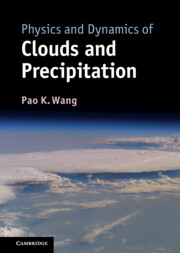Book contents
- Frontmatter
- Contents
- Preface
- 1 Observation of clouds
- 2 The shape and size of cloud and precipitation particles
- 3 Molecular structures of water substance
- 4 Bulk thermodynamic equilibrium among water vapor, liquid water, and ice
- 5 Surface thermodynamics of water substance
- 6 Aerosol in the atmosphere
- 7 Nucleation
- 8 Hydrodynamics of cloud and precipitation particles
- 9 Diffusion growth and evaporation of cloud and precipitation particles
- 10 Collision, coalescence, breakup, and melting
- 11 Cloud drop population dynamics in the warm rain process
- 12 Fundamental cloud dynamics
- 13 Numerical cloud models
- 14 Cloud electricity
- 15 Clouds–environment interaction
- References
- Index
- Plate section
13 - Numerical cloud models
Published online by Cambridge University Press: 05 March 2013
- Frontmatter
- Contents
- Preface
- 1 Observation of clouds
- 2 The shape and size of cloud and precipitation particles
- 3 Molecular structures of water substance
- 4 Bulk thermodynamic equilibrium among water vapor, liquid water, and ice
- 5 Surface thermodynamics of water substance
- 6 Aerosol in the atmosphere
- 7 Nucleation
- 8 Hydrodynamics of cloud and precipitation particles
- 9 Diffusion growth and evaporation of cloud and precipitation particles
- 10 Collision, coalescence, breakup, and melting
- 11 Cloud drop population dynamics in the warm rain process
- 12 Fundamental cloud dynamics
- 13 Numerical cloud models
- 14 Cloud electricity
- 15 Clouds–environment interaction
- References
- Index
- Plate section
Summary
Introduction
In Chapter 12, we examined the fundamental thermodynamic and dynamic processes leading to the formation of clouds, focusing on small convective clouds. We gained some insights into cloud formation and development using a few simple analytical expressions that describe the physical (mainly thermodynamic and dynamic) state of an air parcel in a prescribed environment. Our discussions focused on the processes occurring in the parcel as we followed the ascent or descent of the parcel. This type of discussion (i.e. following a particle or a parcel) is called the Lagrangian description of a dynamic system. Except in the slice model, where the compensating downdraft was treated in a crude manner, we did not consider what happened to the cloud environment in that description.
However, when an air parcel rises and forms a cloud, its dynamics and microphysics will influence the physical states of its environment, not only via forcing compensating downdrafts, but also via the changes in the latent heat that will eventually be transferred to the environment. These changes in the environment, in turn, will cause changes in the cloud by essentially setting different boundary conditions, and so on. In other words, there are feedbacks that the cloud and its environment impart upon each other. The parcel model as described in the last chapter cannot address these feedback effects realistically, especially in the time evolution. In addition, in a real cloud, there are interactions not only between the cloud and its environment, but also between different parts of the cloud as well. Such interactions are especially complicated in a mixed-phase system such as a cumulonimbus, in which both updrafts and downdrafts are present, and different kinds of hydrometeors (including water drops and ice particles, either growing or evaporating) are carried by the cloud circulation into different regions and interact with each other. One cannot hope to describe such interactions by the analytic equations derived in the previous chapter.
- Type
- Chapter
- Information
- Physics and Dynamics of Clouds and Precipitation , pp. 327 - 362Publisher: Cambridge University PressPrint publication year: 2013



